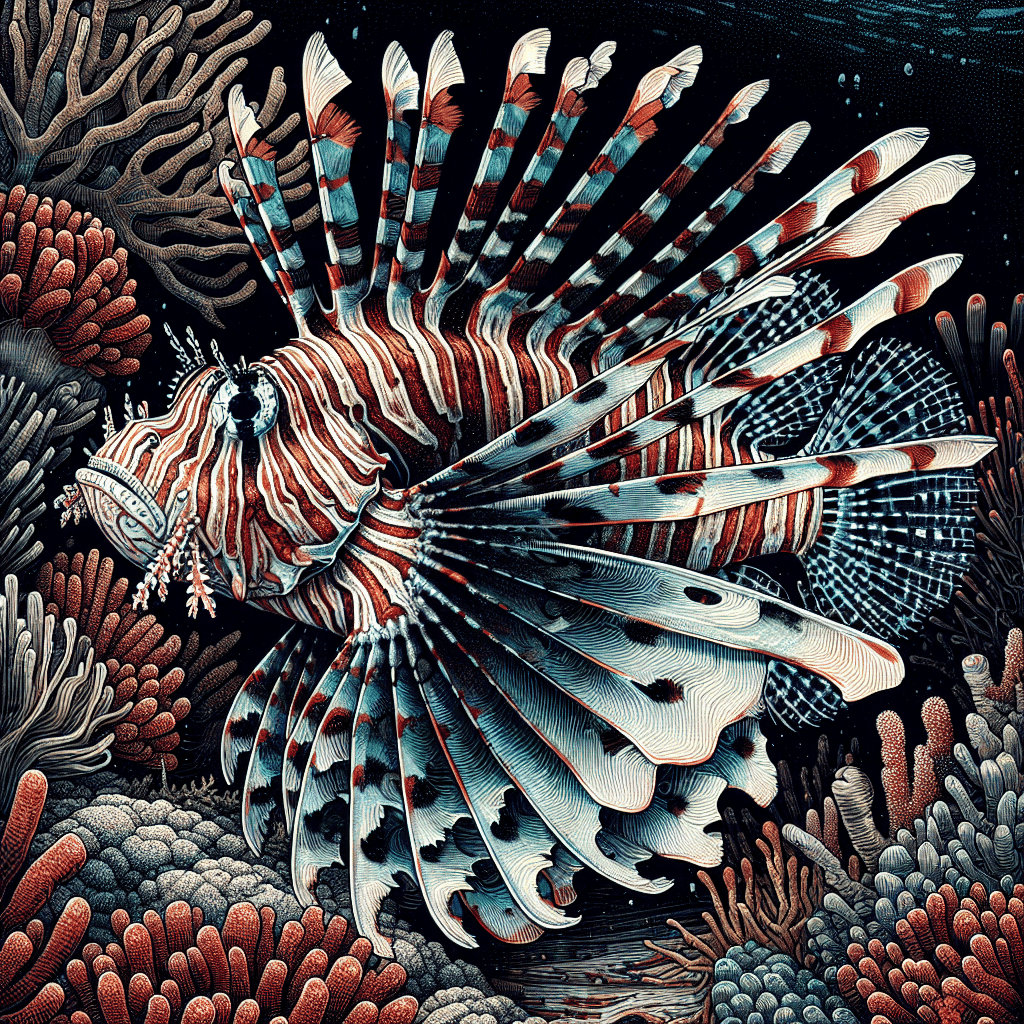The Lawnmower Blenny Overview
Characteristics and Habitat
The lawnmower blenny, scientifically known as Salarias fasciatus, is a peaceful fish that I find particularly appealing for its algae-eating habits. It’s a great addition to any marine aquarium, especially for those of us who want to keep algae growth in check. Although it primarily feeds on algae, it doesn’t exclusively rely on it for sustenance (FantaSEA Aquariums).
These fish thrive in shallow tropical waters, seeking out plenty of film algae and hiding spots. When setting up an aquarium for a lawnmower blenny, it’s essential to provide sufficient hiding spaces, as they are naturally prey fish and prefer to have a safe place to retreat when feeling threatened.
Size and Lifespan
In terms of size, the lawnmower blenny typically grows to about 5 inches long. It reaches this adult size around 18 months of age, at which point it’s considered sexually mature (Light Fish).
Here’s a quick overview of the size and lifespan of the lawnmower blenny:
| Attribute | Measurement |
|---|---|
| Maximum Size | 5 inches |
| Age of Maturity | 18 months |
| Lifespan | 3-5 years |
If you’re considering adding a lawnmower blenny to your reef tank, remember that a single fish should ideally be housed in a minimum of a 30-gallon aquarium. They can also thrive in nano-sized aquariums due to their small dimensions (Light Fish). Providing a suitable environment is key to ensuring they live a healthy and happy life.
Setting Up the Aquarium
Setting up the right environment for my lawnmower blenny is crucial to ensure it thrives in my reef tank. Here’s everything I need to know about tank size and compatible tank mates.
Tank Size and Requirements
I can house a single lawnmower blenny in an aquarium no smaller than 30 gallons. This size is perfect since they are small fish that typically grow to around 5 inches. Larger tanks are also suitable, and they can even thrive in nano-sized aquariums due to their compact size (Light Fish). It’s important to provide plenty of film algae and hiding spots in the aquarium, as these fish are naturally prey and seek shelter when they feel threatened.
| Tank Size | Minimum Gallons | Suitable for |
|---|---|---|
| Small Nano Tank | 30 | 1 Lawnmower Blenny |
| Standard Tank | 30+ | Multiple Tank Mates |
Tank Mates and Compatibility
When it comes to tank mates for my lawnmower blenny, compatibility is key. They generally have a peaceful nature, making them suitable for community tanks with other small reef fish. However, I should avoid keeping them with larger predatory fish, as these are their natural enemies. Good tank mates might include other smaller fish like clownfish, gobies, or wrasses.
Here are some compatible tank mates:
| Compatible Fish | Notes |
|---|---|
| Clownfish | Peaceful and colorful |
| Goby | Similar size and temperament |
| Wrasse | Active and non-aggressive |
| Firefish | Small and compatible |
I should also consider introducing my lawnmower blenny using a drip acclimation process to reduce stress. This ensures a smooth transition into its new home (Light Fish). For a complete guide on how to care for my blenny and other marine species, I can visit marine fish resources.
Care and Feeding
Caring for a lawnmower blenny is pretty straightforward, especially when it comes to its diet. Knowing what to feed them is crucial for keeping them healthy and happy.
Algae-Based Diet
The lawnmower blenny, or Salarias fasciatus, is known for its love of algae, making it a favorite among marine aquarists. While it primarily feeds on algae, this fish does not exclusively eat it. To provide a balanced diet, I focus on a variety of foods. Here’s a quick list of what to include:
- Algae-based foods: These are essential.
- Pellets and gel foods: Look for options that contain spirulina, which is beneficial for their health.
- Blanched vegetables: Things like zucchini or spinach can be great additions.
- Nori seaweed sheets: These are a hit with my blenny and help mimic its natural diet.
I even stimulate algae growth in a separate container to give my blenny a natural source of food. This allows them to graze as they would in the wild. For more information on different types of fish, check out our article on marine fish.
Feeding Schedule and Tips
When it comes to feeding my lawnmower blenny, I find that a consistent schedule works best. Here’s what I do:
| Day | Feeding Schedule |
|---|---|
| Daily | Feed algae-based food or nori |
| 2-3 times a week | Offer pellets or gel foods |
| Weekly | Add blanched vegetables |
I offer them food once a day, ensuring that they eat it all within a few minutes to prevent any excess waste in the tank. Adjusting the feeding frequency based on the blenny’s appetite and the tank’s algae levels is essential. Overfeeding can lead to poor water quality, so I always keep an eye on their eating habits.
By providing a varied diet and maintaining a proper feeding schedule, my lawnmower blenny thrives in the aquarium. It’s all about keeping things balanced and ensuring they have the nutrients they need for a healthy life. If you’re curious about other fish care tips, take a look at our hair straightening products for curly hair for more insights on maintaining aquatic and non-aquatic pets alike!
Behavior and Temperament
Peaceful Nature
The lawnmower blenny, also known as Salarias fasciatus, is a peaceful fish that many marine aquarists love due to its algae-eating habits. I’ve found that these fish tend to get along really well with others that share a similar temperament. Their friendly nature makes them a great addition to a community tank, especially if you’re looking to maintain a healthy reef environment. However, they have their quirks.
Territorial Tendencies
Despite their generally calm demeanor, lawnmower blennies can be territorial. It’s essential to keep in mind that they shouldn’t be housed with other blennies or fish that look like them; otherwise, you might witness some aggressive behavior. They can also be a bit nippy towards certain corals, like polyps and clams, which is why they aren’t considered 100% reef safe (FantaSEA Aquariums).
To help manage their territorial tendencies, I recommend introducing them into a well-established tank. This gives them plenty of space to explore, which can help reduce any signs of aggression. If you’re planning to add other fish, consider those that have distinct appearances to avoid conflicts. For instance, pairing them with fish like clownfish or tangs can often lead to a harmonious environment.
Overall, the lawnmower blenny brings a unique personality to the tank, and understanding its behavior can make for a rewarding experience in your reef tank setup.
Health and Maintenance
Taking care of my lawnmower blenny involves a few crucial steps to ensure they thrive in the aquarium. This section covers the acclimation process and disease prevention strategies.
Acclimation Process
When introducing a lawnmower blenny to my aquarium, I make sure to use a drip acclimation method. This helps reduce stress and allows the fish to gradually adjust to the new water conditions. I typically use a drip acclimation kit for this purpose.
Before placing the blenny into a quarantine tank or display tank, I find it beneficial to use an acclimation box. This provides a safe space for the blenny to acclimate without immediate exposure to other tank members. The process generally takes about 1-2 hours, during which I monitor the water parameters to ensure they match those of the main tank.
Disease Prevention
Preventing disease in my lawnmower blenny is essential for maintaining a healthy reef tank. Here are some key strategies I follow:
Quarantine New Arrivals: I always quarantine new fish for at least 2-4 weeks before introducing them to the main tank. This helps catch any potential diseases early on.
Maintain Water Quality: Regular water testing and maintenance are crucial. I check parameters like pH, salinity, ammonia, nitrites, and nitrates to ensure they are within the ideal ranges for marine fish.
Observe Behavior: Keeping an eye on the blenny’s behavior can help me spot any signs of stress or illness. Common symptoms include changes in appetite and unusual swimming patterns.
Good Nutrition: I provide a balanced diet to support their immune system. A diet rich in algae helps them stay healthy and reduces the risk of disease.
Regular Cleaning: Performing routine tank maintenance, including partial water changes and cleaning the substrate, prevents the buildup of harmful substances.
By following these acclimation and disease prevention steps, I can help ensure that my lawnmower blenny remains healthy and happy in my aquarium. For more tips on maintaining a marine environment, check out our article on marine fish.
Breeding and Reproduction
Breeding lawnmower blennies can be quite an interesting experience for hobbyists. They typically spawn in late spring and early summer, specifically between April and June. During this time, they lay their eggs in empty shells, which the males then fertilize. It’s fascinating to see how this natural behavior can be replicated in a tank environment with the right care.
Breeding Behavior
To encourage breeding, I find that replicating their natural environment is key. This includes maintaining stable water conditions and providing plenty of hiding spots, like rocks and shells, where they can lay their eggs. Interestingly, there is no specific age requirement for sexual maturity, but lawnmower blennies generally reach their adult size of about 5 inches in length at around 18 months of age (Light Fish).
Here’s a quick overview of their breeding timeline:
| Stage | Timeframe |
|---|---|
| Spawning Season | Late Spring to Early Summer |
| Size at Sexual Maturity | About 5 inches (18 months old) |
| Average Lifespan | 3-5 years in captivity |
Larvae Care
Once the eggs are fertilized, the young larvae will stay in shallow water and feed on plankton. Care for the larvae involves maintaining the right environment with adequate food sources. It’s important to keep the water clean and free from any contaminants that could harm the delicate larvae.
If you’re considering breeding lawnmower blennies, be prepared to provide a nurturing environment for the larvae until they are ready to transition into the main tank. This often involves careful monitoring and possibly transferring them to a nursery tank where they can grow safely.
For more information on other marine fish and their breeding behaviors, check out my articles on marine fish and various species like clownfish and goby.
Fun Facts and Trivia
Color Changing Abilities
One of the most fascinating traits of the Lawnmower Blenny is its ability to change color. This fish can alter its coloration to blend in with its environment and reflect its mood. This adaptability helps it avoid predators and can be particularly striking when it shifts hues based on its surroundings. I find it amazing how these little fish can appear long and slender, with their vertically oriented pectoral and pelvic fins, which let them perch comfortably on rocks while looking for algae to munch on (Boodleshire Aquatics).
Common Names and Origins
The Lawnmower Blenny is known by several common names, including the Jeweled Rockskipper, algae blenny, and banded blenny. Scientifically, it’s referred to as Salarias fasciatus, and it was first discovered back in 1786. This species primarily resides in shallow saltwater environments and is mostly found in Australasia, particularly around the islands of Micronesia. While it’s not sought after as a commercial fish for food, it has become a popular addition in home aquariums due to its unique color-changing abilities and peaceful demeanor (A-Z Animals).
Here’s a quick table summarizing its common names and some origins:
| Common Name | Scientific Name | Region of Origin |
|---|---|---|
| Lawnmower Blenny | Salarias fasciatus | Australasia, Micronesia |
| Jeweled Rockskipper | Salarias fasciatus | Australasia |
| Algae Blenny | Salarias fasciatus | Australasia |
| Banded Blenny | Salarias fasciatus | Australasia |
The Lawnmower Blenny is a delightful fish that adds both beauty and function to a reef tank, making it an excellent choice for aquarium enthusiasts. If you’re interested in more marine fish, check out our articles on blenny or clownfish.
Conservation Status
Population and Conservation Efforts
The Lawnmower Blenny is primarily found in the waters of Australasia, ranging from East Africa to the Islands of Micronesia. Although its population is currently unknown, the species is considered to be of least concern according to the IUCN Redlist of endangered species. This means that there are no immediate threats to their survival, and they are not classified as extinct. Interestingly, no specific conservation efforts are in place for the Lawnmower Blenny, as they are often kept as pets and bred in captivity, eliminating the need to source them from the wild.
| Conservation Status | Population Status | Conservation Efforts |
|---|---|---|
| Least Concern | Unknown | None currently in place |
Predators and Threats
In the wild, the Lawnmower Blenny faces predation from larger fish such as bluefish, weakfish, and striped bass. To evade these predators, they utilize their ability to change color, which helps them blend into their surroundings. This camouflage strategy is essential for their survival, especially in reef environments where larger fish are common.
Understanding both the conservation status and the threats faced by the Lawnmower Blenny can help hobbyists make informed decisions about keeping them in their aquariums. By choosing to care for these fish, aquarists contribute to their well-being and support the possibility of breeding them in captivity. If you’re interested in learning more about various marine species, check out our articles on marine fish and specific species such as clownfish and tang.



